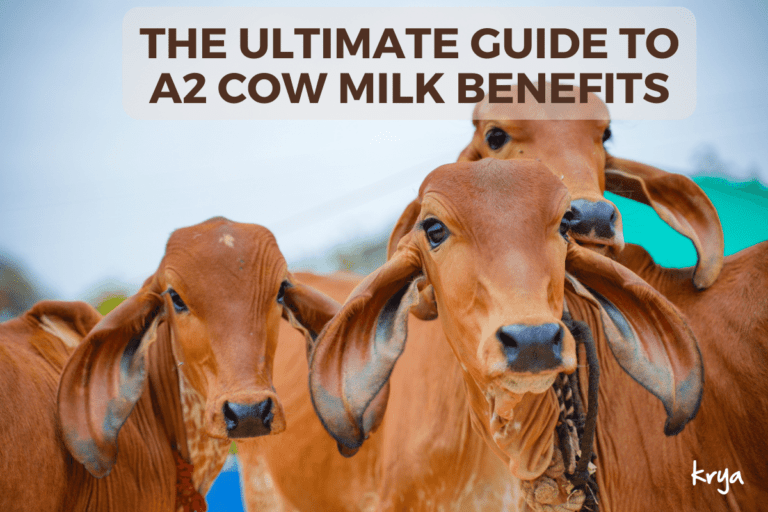
Cow’s milk is an important food in Ayurveda. Regular intake is said to improve ojas, tejas, build good dhatu and positively impacts physical and mental health and nutrient availability in the body. However today we get many varieties of cow’s milk. Are these all the same? What are the a2 cow milk benefits for us? In this article we analyze milks from an ayurvedic perspective . What Milk is widely available in India today? The predominant, widely available milk in India is processed, homogenized, pasteurized milk sourced from large cooperatives and conglomerates. They follow a collection + aggregation model. Here Milk is sourced from small dairy farmers with any breed of cow or buffalo, mixed together, homogenized to follow government standards of fat percentage and then sold as toned milk, full fat milk, etc. Which in turn use a mixture of own milk and aggregated milk. This is the case for all major cooperative dairy conglomerates across India. Problems with Commercial Mixed / A1 Milk type • Milk is sourced from different kinds of daily cattle and mixed together: so we have desi (A2), foreign (jersey – A1), hybrid (desi+jersey), buffalo, and sometimes goats milk being mixed together. The properties of each of these are different and will have a different effect on the body. Depending upon the mixture we get, the body may accept it better or it may not. • As Dairy farmers are rewarded for fat percentage of Milk (higher cost paid for higher milk fat), they are incentivized to replace lean indigenous breeds with foreign breeds which are naturally high in fat. Again to conserve milk fat, they restrict the animal’s movement and can feed the Animal high fat and unsuitable diet in order to extract high fat milk. • Unnatural, cruel dairy farming practices: To extract maximum yield from […]
The abhyanga is a powerful Dinacharya that gives us good health and well being. When done regularly it helps improve strength, balance aggravated doshas and also improves skin health and hair health. However, as we have seen, Ayurveda also advises following Ritucharya practices. These are changes / modifications to food habits and daily practices in each season. In today’s post we will look at the abhyanga modification to be done for Spring (Vasanta Ritu). In our earlier post on Vasanta Ritucharya, we have covered why a change in habits is required in this season. In Spring (Vasanta Ritu), just like ice melts in the Mountain tops due to the presence of the sun, the Sun’s movement helps melt accumulated Kapha in our bodies too. As this Kapha beings to circulate in the body, we experience a surfeit of mucous related issues like colds, runny noses, hay fever, etc. Particularly if we did not follow the Ritucharya rule in Winter about putting accumulated Kapha to work through intensive exercise, we will have to deal with aggravated Kapha in spring. The presence of this liquid Kapha in the body creates a few challenges to the practice of abhyanga in spring. As there is more Kapha circulating in the body, there is a resistance to oil absorption. Also, as Kapha tends to increase heaviness and stiffness in the body, we must be VERY careful during Abhyanga NOT to contribute further to this feeling of “gurutva” or heaviness and stiffness in the body. Abhyanga Contraindications : Before we get into the post on the abhyanga modification to be done in spring, here are some basic precautions to follow while attempting this Dinacharya. Do NOT do Abhyanga is you are pregnant or are menstruating Do NOT do Abhyanga if you are tired, have had low […]

A common question we get asked at Krya is about healthy eating timings & habits to follow and meal choices at each time. Today, the media is charged with advice on nutrition and the importance of developing healthy eating habits. Often, these so-called studies also become quite contradictory, and we naturally start looking for some genuine and time tested guidance on on ahara (food) and ahara niyama (dietary practices to observe). A key part of ahara niyama (or healthy eating habits) in Ayurveda is to identify the proper/healthy time to eat. This influences our capacity to digest food and extract nutrients from the food. In fact, choosing the correct time to eat each meal has the same effect on our health as choosing what to eat. In other words, we should spend the same amount of time planning when to eat as planning what to eat. In this post, we are going to see why Ayurveda pays so much attention to meal timing and how this is a key part of developing healthy eating habits. Planning healthy eating schedule: Different doshas influence different dayparts Ayurveda tells us that each day is divided into 4-hour dayparts. Each of these dayparts is connected to the slow rise, peaking, and then falling of a particular dosha in our body. The strength of the surge in the dosha depends upon the movement of the Sun. For example, if there is sunshine during the kapha period, the effect of kapha will be slightly reduced. Similarly, if there is good sunshine, say during a pitta part of the day, pitta will be much more aggravated due to the influence of the Sun. In order to take advantage of these natural surges in a particular dosha, we are advised to do certain activities during certain parts of […]
The Abhyanga is a key Dinacharya, daily practice recommended in Ayurveda to impart Bala (strength), Ayush (health and Immunity) and Ayu (long life) to the body. This practice forms an important part of Krya’s recommendations to improve hair growth, impart better strength and texture to hair and to also improve the quality, tone and texture of skin. An abhyanga is also a very important Dincharya that is recommended for specific cases of hairfall like post partum hairfall, hairfall due to sudden and extreme weight loss (cases of high vata aggravation). Many Krya consumers have found a HUGE difference to their hair health, skin texture and overall well being and immunity when abhyanga is added to their daily routine. The practice of abhyanga is mentioned as a health giving practice in all the Ayurvedic Samhitas. In today’s post, we will analyse the abhyanga shloka in Ashtanga Hridayam’s Dinacharya chapter and see why Acharya Vagbhatta says this is such an important and useful practice. Ashtanga Hridayam: part of the Brhat Trayee Texts in Ayurveda We have written often about how empowering Ayurveda is as a Vaidya shastra. Ayurveda is considered an UpaVeda, an offshoot of the vedas themselves and is found in the Atharva Veda. This Upa Veda is a Divine Science which has been handed down from the Devas to the Raja Rishis. It was then passed down in oral tradition until it was compiled about 3000 – 4000 years ago by Agnivesa. Agnivesa’s Samhita, was then further redacted by Charaka. Charaka’s redaction of Agnivesa Samhita became much more famous than the original, and soon everyone began to refer to Charaka’s redaction as the Charaka Samhita. Charaka Samhita forms the first of the Brhita Trayee. The second text in the Brihat Trayee is Sushruta Samhita. The Sushruta Samhita concentrates more on […]

According to Ayurvedic seasonal guidelines, Vasanta / spring is now here – so we must all be following Vasanta Ritucharya – modified seasonal guidelines for Spring. If you have already begun to sniffle, sneeze and look desperately for tissues, this season change may have already caught you unawares. One of the most powerful concepts in Ayurveda medicine is the concept of Ritucharya – seasonal regimens to be followed to naturally balance the changes in your doshas due to the change in climate and season. As we have seen in other posts on Ritucharya and Dinacharya, following daily living guidelines or Dinacharya and adjusting these guidelines in every season, or Ritucharya are 2 key ayurvedic cornerstones to good health. When we regularly follow the guidelines of Dinacharya and Ritucharya and also ensure that our choice of Ahara (food) and the way we prepare and eat this food is according to our prakriti, we ensure we are in a state of harmony and balance. This is the Ayurvedic concept of preventive health care. Ayurveda: unique concept of preventive health care Ayurveda’s goal is to prevent the formation of disease by following certain guidelines of good living. This is best described by Acharya Charaka in his Sutra Sthana shlokas: “Swasthasya Swasthya Rakshanam Aaturasya Vikara Prashamanam Cha” He explains that the goal of medicine (Ayurveda) is to rejuvenate and preserve the health of the healthy and then to alleviate diseases in the ill. This order of first tending to the healthy and then treating the sick is specific to Ayurveda. It explains why so much of Ayurveda is primarily focused on health giving regimens rather than disease treatment . This emphasis on preserving health is why Dincharya and Ritucharya regimes (regimes for daily living and special regimes to follow in specific seasons) come first […]




